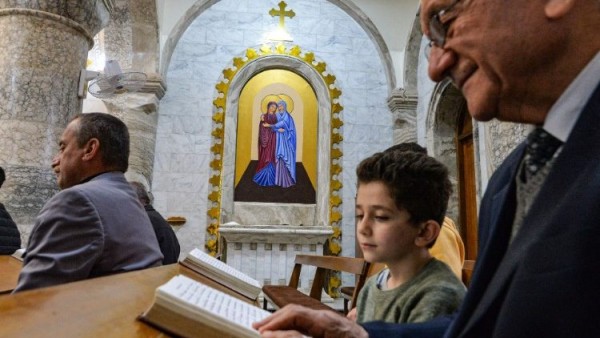
Iraqi Christians attend a prayer service at the Syriac Catholic Church in Qaraqosh (AFP or licensors)
Ishtartv.com
- vaticannews.va
By Emil Anton
Modern Iraq covers most of the
area of ancient Mesopotamia, which was home to the East Semitic Assyrian and
Babylonian empires.
The Old Testament records the
fall of Nineveh, the capital of Assyria (612 BC), as well as the invasion of
Babylon by Cyrus the Great of Persia (539 BC). After a period of Greek rule
following the conquests of Alexander the Great (4th to 2nd centuries
BC), Mesopotamia was again under Persian (Parthian) rule at the time of
Jesus and the Apostles.
Aramaic was the main language
spoken in the entire area at the time Jesus walked the earth. A close relative
of Hebrew, Aramaic was the language of the ancient West Semitic Arameans, who
brought it to Mesopotamia from what is now Syria. With its handy alphabetic
writing, Aramaic gradually replaced Assyrian and Babylonian cuneiform, becoming
the lingua franca of the Middle East. It is still spoken today by
many Iraqi Christians.
Christian Mesopotamia
When and how did Christianity
spread to Mesopotamia?
We know that there were Parthians
and Mesopotamians—ancient Iraqis—present in Jerusalem at Pentecost (Acts 2:9).
And it is possible, if not probable, that some knowledge or version of
Christianity made its way to what is now Iraq during the lifetime of the
Apostles. Tradition identifies the apostles of Mesopotamia as Addai and Mari,
after whom the ancient liturgy of the Church of the East is named.
The Teaching of Addai, an
important document from around 400 AD, suggests that miracles (such as
healings), reasoned arguments (against polytheism), and new ethical standards
laid the groundwork for the spread of Christianity throughout Mesopotamia. As
happened in the West, the blood of martyrs also proved to be the seed of the
Church in this region.
Church of the East
“The Church of the East” refers
to the church that organized itself in the Persian empire. Under the
Zoroastrian Persians, Christians were sometimes cruelly persecuted, while at
other times they enjoyed recognition as a respectable, minority religion.
The Church of the East, with its
patriarchs residing at the Persian capital, Seleucia-Ctesiphon, held its own
Councils in the early 5th century.
At these Councils, the Church
accepted the Nicene Creed but ended up asserting its independence from the
Western Church for political reasons. These included loyalty to the Persian
shah, who was often at war with the neighboring Byzantines.
East and West Syriacs
From the 5th to
6th centuries on, the Aramaic-speaking or Syriac Christians of Iraq were
split into two groups, following the Christological controversies concerning
the union of the human and divine natures in Christ.
The Church of the East, which did
not attend the Council of Ephesus (431) or endorse its condemnation of
Nestorius, received the name “Nestorian”. Another faction, called “Jacobite”
(after Jacob Baradaeus), was born out of the Syrian-Antiochene Monophysite
rejection of the Council of Chalcedon (451).
Besides their theological
differences, the Syriac script and dialects also diverged, contributing to the
development of the West Syriac (Jacobite) and East Syriac (Nestorian) literary
and liturgical traditions.
In the Middle Ages, during the
Islamic Abbasid empire, the Nestorian patriarchs resided in the new capital,
Baghdad. Here, they were close to the caliphs, with whom the patriarchs
sometimes engaged in interreligious dialogue and debate. The most famous
example of this is the dialogue which Patriarch Timothy I held with the caliph
Al-Mahdi.
The Jacobite Catholicos (also
known as maphrian) resided in Tikrit, or at the impressive Mar Mattai
Monastery near Mosul. The most eminent Jacobite Catholicos was Barhebraeus, an
encyclopedic scholar of the 13th century.
Uniate Churches
After periods of Mongol,
Turkoman, and Safavid rule, Mesopotamia fell under the Ottomans, whose empire
lasted until the First World War in the early 20th century.
It was in this period that the
East and West Syriac Uniate Churches – the Chaldean Catholic Church and the
Syriac (or Syrian) Catholic Church, respectively – were formed.
The Syriac Catholic Church was
created when a Jacobite patriarch united with Rome in the 18th century.
The Bishops who did not join the union formed the Syriac Orthodox Church.
Today’s Chaldean Catholic Church
dates back to 1830, when the historical patriarchate of the Church of the East
was united with an earlier Chaldean branch created in the 17th century.
An even-earlier Uniate branch
from the 16th century later separated from Rome, and developed into what
are today the Assyrian Church of the East and the Ancient Church of the East.
Rich history
To put it briefly, Iraq has a
uniquely rich Aramaic, or Syriac, Christian history.
In this land are found two West
Syriac and three East Syriac communities, as well as two Uniate and three
non-Uniate Churches.
And no mention has been made of
the other ethnic (Armenian and Coptic) and Protestant minorities!
Yet, during persecutions,
pandemics, and papal visits, Iraqi Christians will certainly resonate with
Jesus’ words: “You are all brothers” (Mt 23:8).
|